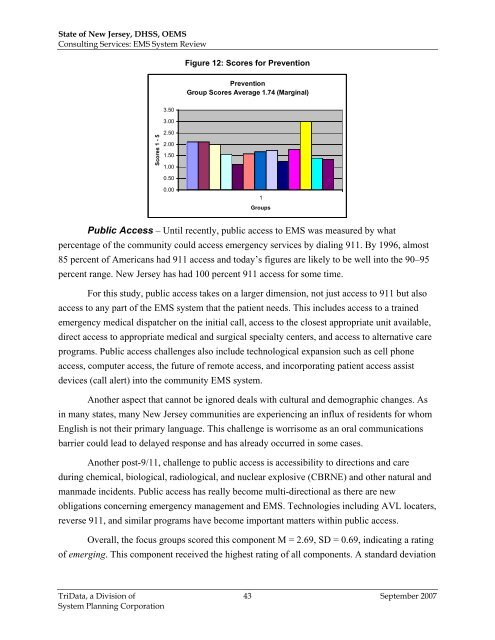EMS System Review - State of New Jersey
EMS System Review - State of New Jersey
EMS System Review - State of New Jersey
- No tags were found...
Create successful ePaper yourself
Turn your PDF publications into a flip-book with our unique Google optimized e-Paper software.
<strong>State</strong> <strong>of</strong> <strong>New</strong> <strong>Jersey</strong>, DHSS, O<strong>EMS</strong>Consulting Services: <strong>EMS</strong> <strong>System</strong> <strong>Review</strong>Figure 12: Scores for PreventionPreventionGroup Scores Average 1.74 (Marginal)Scores 1 - 53.503.002.502.001.501.000.500.001GroupsPublic Access – Until recently, public access to <strong>EMS</strong> was measured by whatpercentage <strong>of</strong> the community could access emergency services by dialing 911. By 1996, almost85 percent <strong>of</strong> Americans had 911 access and today’s figures are likely to be well into the 90–95percent range. <strong>New</strong> <strong>Jersey</strong> has had 100 percent 911 access for some time.For this study, public access takes on a larger dimension, not just access to 911 but alsoaccess to any part <strong>of</strong> the <strong>EMS</strong> system that the patient needs. This includes access to a trainedemergency medical dispatcher on the initial call, access to the closest appropriate unit available,direct access to appropriate medical and surgical specialty centers, and access to alternative careprograms. Public access challenges also include technological expansion such as cell phoneaccess, computer access, the future <strong>of</strong> remote access, and incorporating patient access assistdevices (call alert) into the community <strong>EMS</strong> system.Another aspect that cannot be ignored deals with cultural and demographic changes. Asin many states, many <strong>New</strong> <strong>Jersey</strong> communities are experiencing an influx <strong>of</strong> residents for whomEnglish is not their primary language. This challenge is worrisome as an oral communicationsbarrier could lead to delayed response and has already occurred in some cases.Another post-9/11, challenge to public access is accessibility to directions and careduring chemical, biological, radiological, and nuclear explosive (CBRNE) and other natural andmanmade incidents. Public access has really become multi-directional as there are newobligations concerning emergency management and <strong>EMS</strong>. Technologies including AVL locaters,reverse 911, and similar programs have become important matters within public access.Overall, the focus groups scored this component M = 2.69, SD = 0.69, indicating a rating<strong>of</strong> emerging. This component received the highest rating <strong>of</strong> all components. A standard deviationTriData, a Division <strong>of</strong> 43September 2007<strong>System</strong> Planning Corporation



